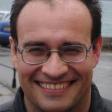
Alexei Zhurov
Applications of the Average Face
in Orthodontic and Genetic Studies
To describe the use of three-dimensional average facial templates in various orthodontic and genetic applications.
The paper applies to quantitative facial studies of any cohort of population with an arbitrary number of subjects, males or females, children or adults, normal or with abnormalities. Three-dimensional surface facial scans can be acquired using laser or optical imaging systems (e.g., Konica Minolta 900/910, 3dMD, Canfield Vectra, etc.). The images are further processed on a computer to stitch together individual portions, remove noise and unwanted data, and improve the mesh quality. This results in 3D facial shells typically accurate to within 0.5–1mm. With the method suggested and reported by the authors previously, average facial shells are constructed for selected groups of images. The algorithm registers images by removing relative translations, rotations, and size differences and performs several iterative averaging steps; three or four steps usually suffice. The algorithm relies on the surface information and may or may not use additional landmark data if available. The average faces of all groups of interest are then used to describe differences between the groups.
This approach has proven its utility in quantifying and visualising various effects in previously reported studies. Some of these include: (i) effect of skeletal disproportions and syndromes on face shape, including cleft lip and palate, facial asymmetry, breathing disorders, and atopy, (ii) effect of principal components of facial variation on face shape, (iii) effect of variant rs7559271 in gene PAX3 on nasion, (iv) evaluation of Class III malocclusion in young children, and others. Related studies that are currently underway include: (i) classification of nose shape, (ii) classification of lip shape, (iii) effect of genetic variants associated with nose and lip shapes, (iv) evaluation of a method for treating facial asymmetry, (v) evaluation of face variations due to gender, ethnic, and individual differences, and more.
Average facial templates have great potential for orthodontic and genetic studies helping quantify and visualise various effects on the face, assess the effectiveness of treatment methods, describe differences between various groups of population.
Biography
Graduated from Moscow Institute of Physics and Technology, Russia in 1990 as an MSc in Applied Mathematics, with honours. Received his PhD (Appl Math) in 1995, Institute for Problems in Mechanics of the Russian Academy of Sciences (IPM RAN). Senior Researcher at IPM RAN (since 1990, part time since 2001). Research Officer at Cardiff University (since 2001), United Kingdom. Research interests include nonlinear mechanics, differential equations, mathematical physics, biomechanics, three-dimensional imaging and analysis of the face.
